light RENAULT KOLEOS 2015 1.G User Guide
[x] Cancel search | Manufacturer: RENAULT, Model Year: 2015, Model line: KOLEOS, Model: RENAULT KOLEOS 2015 1.GPages: 232, PDF Size: 18.18 MB
Page 21 of 232
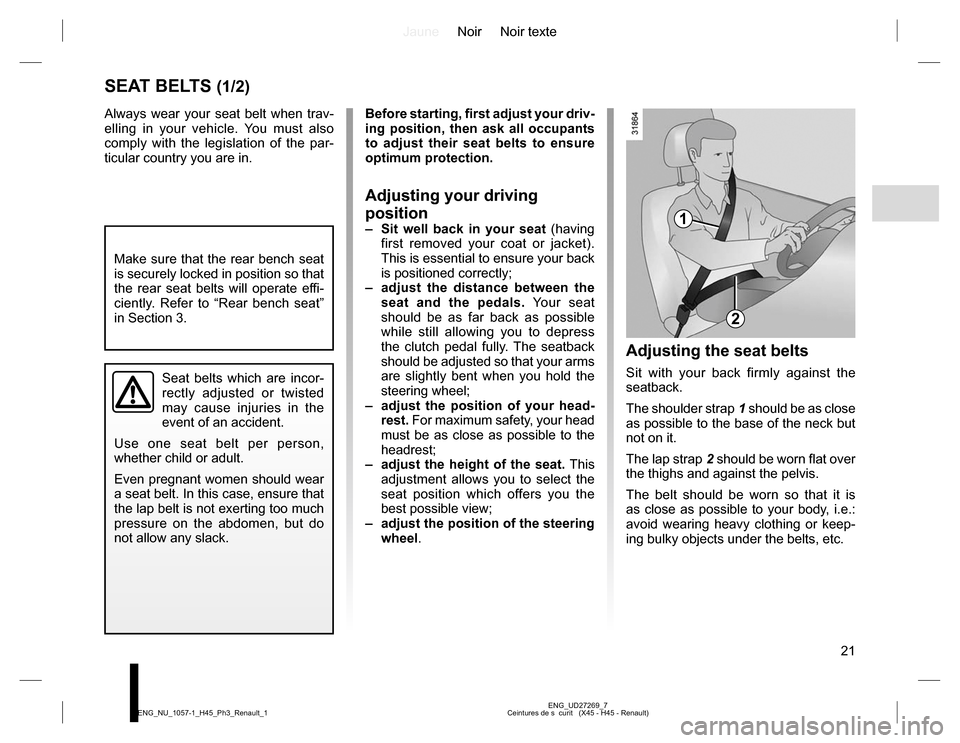
JauneNoir Noir texte
21
ENG_UD27269_7
Ceintures de s curit (X45 - H45 - Renault) ENG_NU_1057-1_H45_Ph3_Renault_1
SEAT BELTS (1/2)
1
2
Always wear your seat belt when trav-
elling in your vehicle. You must also
comply with the legislation of the par-
ticular country you are in.
Adjusting the seat belts
Sit with your back firmly against the
seatback.
The shoulder strap 1 should be as close
as possible to the base of the neck but
not on it.
The lap strap 2 should be worn flat over
the thighs and against the pelvis.
The belt should be worn so that it is
as close as possible to your body, i.e.:
avoid wearing heavy clothing or keep-
ing bulky objects under the belts, etc.Seat belts which are incor-
rectly adjusted or twisted
may cause injuries in the
event of an accident.
Use one seat belt per person,
whether child or adult.
Even pregnant women should wear
a seat belt. In this case, ensure that
the lap belt is not exerting too much
pressure on the abdomen, but do
not allow any slack.
Make sure that the rear bench seat
is securely locked in position so that
the rear seat belts will operate effi-
ciently. Refer to “Rear bench seat”
in Section 3.
Before starting, first adjust your driv-
ing position, then ask all occupants
to adjust their seat belts to ensure
optimum protection.
Adjusting your driving
position
– Sit well back in your seat (having
first removed your coat or jacket).
This is essential to ensure your back
is positioned correctly;
– adjust the distance between the
seat and the pedals. Your seat
should be as far back as possible
while still allowing you to depress
the clutch pedal fully. The seatback
should be adjusted so that your arms
are slightly bent when you hold the
steering wheel;
– adjust the position of your head-
rest. For maximum safety, your head
must be as close as possible to the
headrest;
– adjust the height of the seat. This
adjustment allows you to select the
seat position which offers you the
best possible view;
– adjust the position of the steering
wheel.
Page 22 of 232
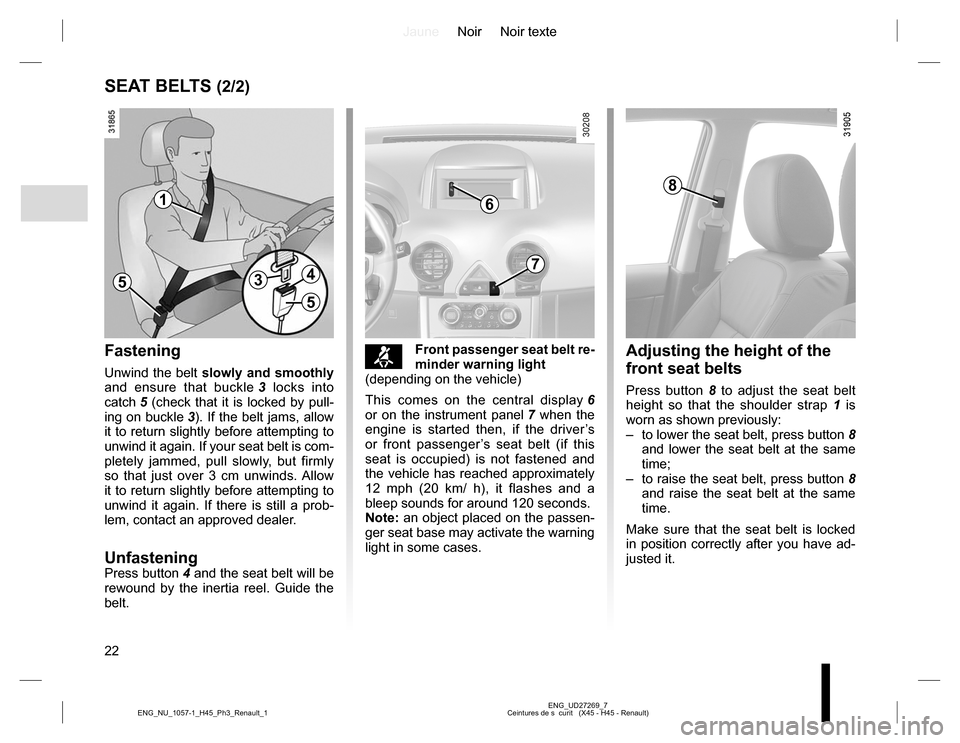
JauneNoir Noir texte
22
ENG_UD27269_7
Ceintures de s curit (X45 - H45 - Renault) ENG_NU_1057-1_H45_Ph3_Renault_1
SEAT BELTS (2/2)
Adjusting the height of the
front seat belts
Press button 8 to adjust the seat belt
height so that the shoulder strap 1 is
worn as shown previously:
– to lower the seat belt, press button 8
and lower the seat belt at the same
time;
– to raise the seat belt, press button 8
and raise the seat belt at the same
time.
Make sure that the seat belt is locked
in position correctly after you have ad-
justed it.
Fastening
Unwind the belt slowly and smoothly
and ensure that buckle 3 locks into
catch 5 (check that it is locked by pull-
ing on buckle 3). If the belt jams, allow
it to return slightly before attempting to
unwind it again. If your seat belt is com-
pletely jammed, pull slowly, but firmly
so that just over 3 cm unwinds. Allow
it to return slightly before attempting to
unwind it again. If there is still a prob-
lem, contact an approved dealer.
UnfasteningPress button 4 and the seat belt will be
rewound by the inertia reel. Guide the
belt.
8
61
534
5
™Front passenger seat belt re-
minder warning light
(depending on the vehicle)
This comes on the central display 6
or on the instrument panel 7 when the
engine is started then, if the driver’s
or front passenger’s seat belt (if this
seat is occupied) is not fastened and
the vehicle has reached approximately
12 mph (20 km/ h), it flashes and a
bleep sounds for around 120 seconds.
Note: an object placed on the passen-
ger seat base may activate the warning
light in some cases.
7
Page 26 of 232
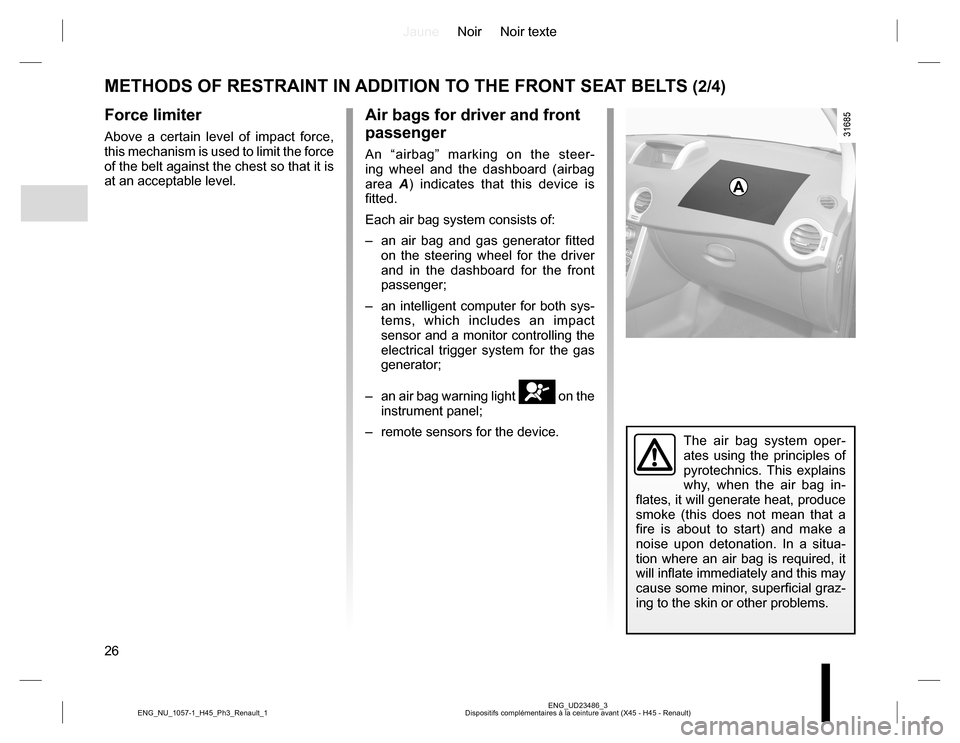
JauneNoir Noir texte
26
ENG_UD23486_3
Dispositifs complémentaires à la ceinture avant (X45 - H45 - Renault) ENG_NU_1057-1_H45_Ph3_Renault_1
METHODS OF RESTRAINT IN ADDITION TO THE FRONT SEAT BELTS (2/4)
Force limiter
Above a certain level of impact force,
this mechanism is used to limit the force
of the belt against the chest so that it is
at an acceptable level.
Air bags for driver and front
passenger
An “airbag” marking on the steer-
ing wheel and the dashboard (airbag
area A) indicates that this device is
fitted.
Each air bag system consists of:
– an air bag and gas generator fitted
on the steering wheel for the driver
and in the dashboard for the front
passenger;
– an intelligent computer for both sys-
tems, which includes an impact
sensor and a monitor controlling the
electrical trigger system for the gas
generator;
– an air bag warning light
å on the
instrument panel;
– remote sensors for the device.
The air bag system oper-
ates using the principles of
pyrotechnics. This explains
why, when the air bag in-
flates, it will generate heat, produce
smoke (this does not mean that a
fire is about to start) and make a
noise upon detonation. In a situa-
tion where an air bag is required, it
will inflate immediately and this may
cause some minor, superficial graz-
ing to the skin or other problems.
A
Page 27 of 232
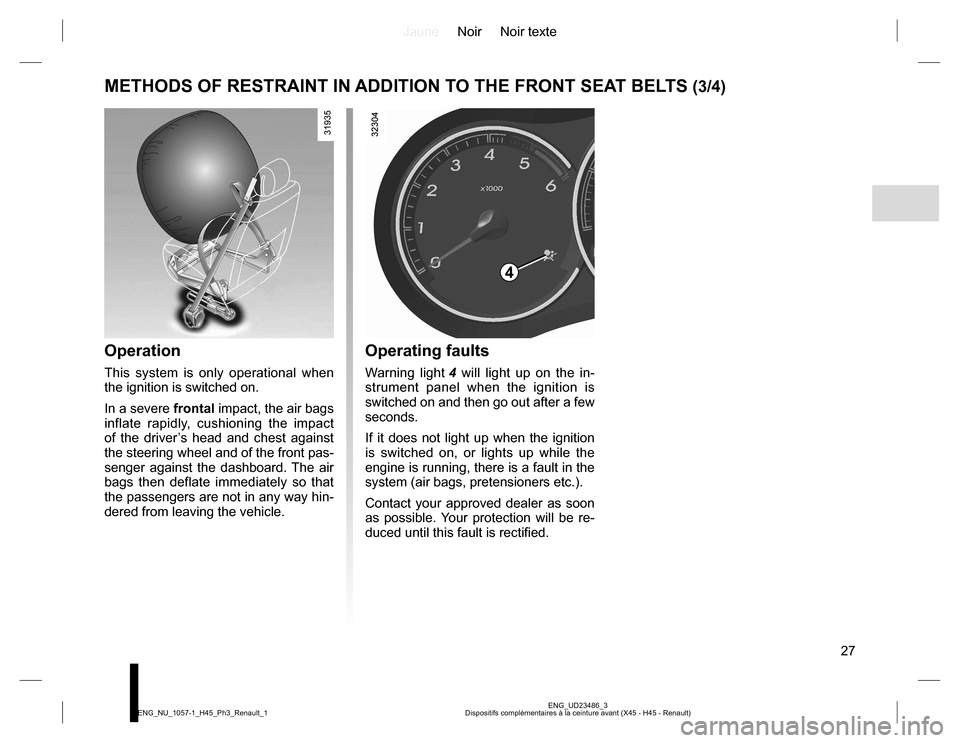
JauneNoir Noir texte
27
ENG_UD23486_3
Dispositifs complémentaires à la ceinture avant (X45 - H45 - Renault) ENG_NU_1057-1_H45_Ph3_Renault_1
METHODS OF RESTRAINT IN ADDITION TO THE FRONT SEAT BELTS (3/4)
Operation
This system is only operational when
the ignition is switched on.
In a severe frontal impact, the air bags
inflate rapidly, cushioning the impact
of the driver’s head and chest against
the steering wheel and of the front pas-
senger against the dashboard. The air
bags then deflate immediately so that
the passengers are not in any way hin-
dered from leaving the vehicle.
Operating faults
Warning light 4 will light up on the in-
strument panel when the ignition is
switched on and then go out after a few
seconds.
If it does not light up when the ignition
is switched on, or lights up while the
engine is running, there is a fault in the
system (air bags, pretensioners etc.).
Contact your approved dealer as soon
as possible. Your protection will be re-
duced until this fault is rectified.
4
Page 28 of 232
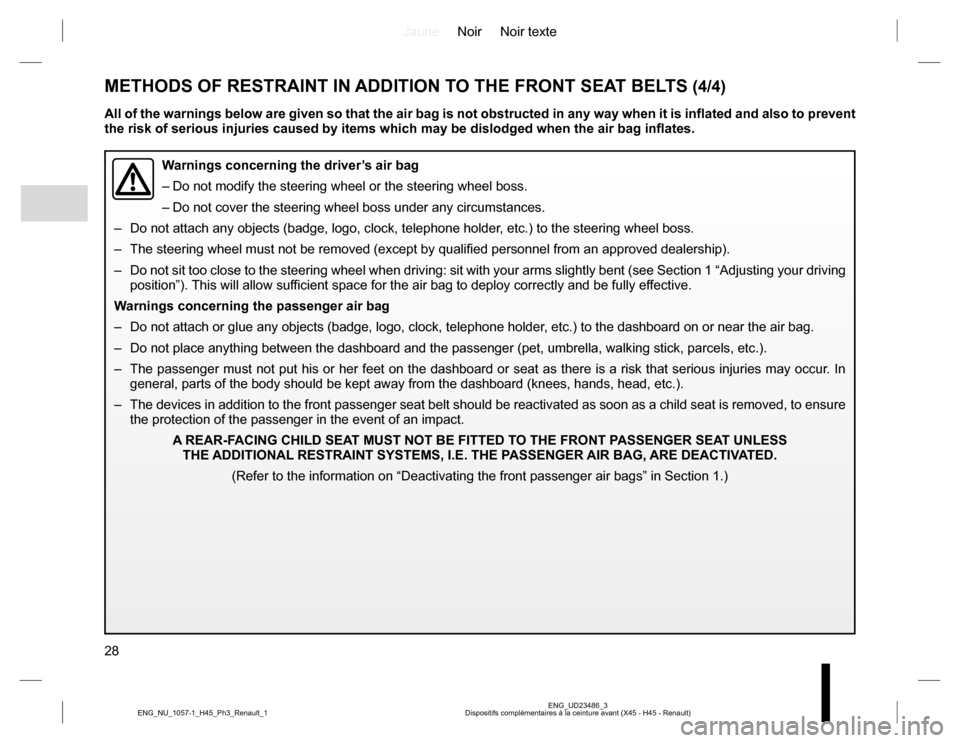
JauneNoir Noir texte
28
ENG_UD23486_3
Dispositifs complémentaires à la ceinture avant (X45 - H45 - Renault) ENG_NU_1057-1_H45_Ph3_Renault_1
METHODS OF RESTRAINT IN ADDITION TO THE FRONT SEAT BELTS (4/4)
All of the warnings below are given so that the air bag is not obstructed in any way when it is inflated and also to prevent
the risk of serious injuries caused by items which may be dislodged when the air bag inflates.
Warnings concerning the driver’s air bag
– Do not modify the steering wheel or the steering wheel boss.
– Do not cover the steering wheel boss under any circumstances.
– Do not attach any objects (badge, logo, clock, telephone holder, etc.) to the steering wheel boss.
– The steering wheel must not be removed (except by qualified personnel from an approved dealership).
– Do not sit too close to the steering wheel when driving: sit with your arms slightly bent (see Section 1 “Adjusting your driving
position”). This will allow sufficient space for the air bag to deploy correctly and be fully effective.
Warnings concerning the passenger air bag
– Do not attach or glue any objects (badge, logo, clock, telephone holder, etc.) to the dashboard on or near the air bag.
– Do not place anything between the dashboard and the passenger (pet, umbrella, walking stick, parcels, etc.).
– The passenger must not put his or her feet on the dashboard or seat as there is a risk that serious injuries may occur. In
general, parts of the body should be kept away from the dashboard (knees, hands, head, etc.).
– The devices in addition to the front passenger seat belt should be reactivated as soon as a child seat is removed, to ensure
the protection of the passenger in the event of an impact.
A REAR-FACING CHILD SEAT MUST NOT BE FITTED TO THE FRONT PASSENGER SEAT UNLESS
THE ADDITIONAL RESTRAINT SYSTEMS, I.E. THE PASSENGER AIR BAG, ARE DEACTIVATED.
(Refer to the information on “Deactivating the front passenger air bags” in Section 1.)
Page 37 of 232
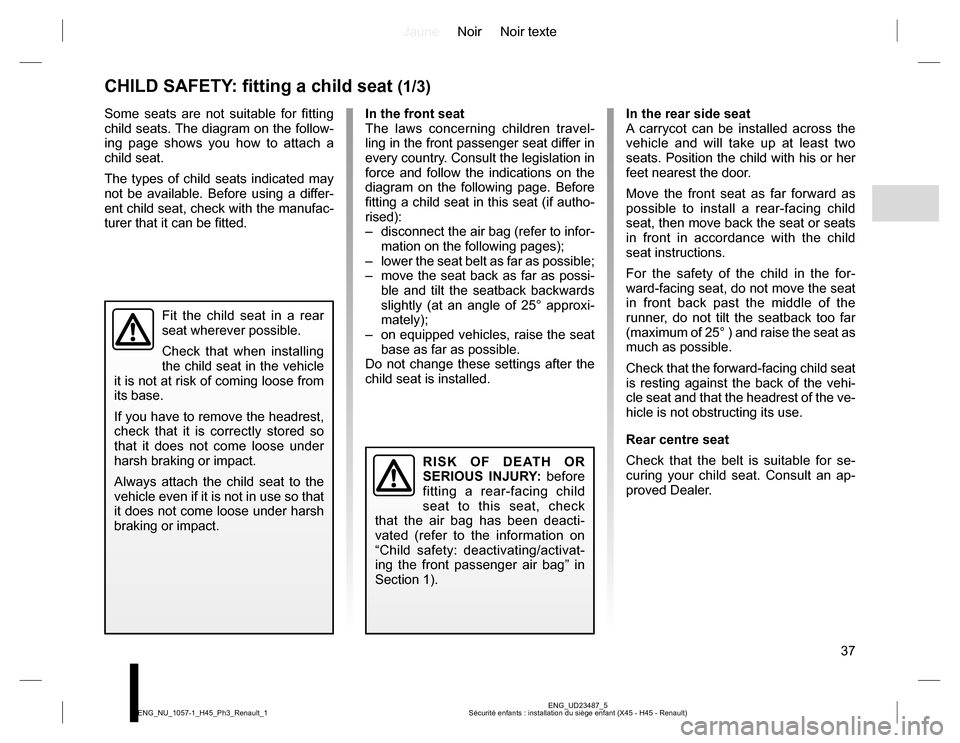
JauneNoir Noir texte
37
ENG_UD23487_5
Sécurité enfants : installation du siège enfant (X45 - H45 - Renault) ENG_NU_1057-1_H45_Ph3_Renault_1
CHILD SAFETY: fitting a child seat (1/3)
In the rear side seat
A carrycot can be installed across the
vehicle and will take up at least two
seats. Position the child with his or her
feet nearest the door.
Move the front seat as far forward as
possible to install a rear-facing child
seat, then move back the seat or seats
in front in accordance with the child
seat instructions.
For the safety of the child in the for-
ward-facing seat, do not move the seat
in front back past the middle of the
runner, do not tilt the seatback too far
(maximum of 25° ) and raise the seat as
much as possible.
Check that the forward-facing child seat
is resting against the back of the vehi-
cle seat and that the headrest of the ve-
hicle is not obstructing its use.
Rear centre seat
Check that the belt is suitable for se-
curing your child seat. Consult an ap-
proved Dealer.
RISK OF DEATH OR
SERIOUS INJURY: before
fitting a rear-facing child
seat to this seat, check
that the air bag has been deacti-
vated (refer to the information on
“Child safety: deactivating/activat-
ing the front passenger air bag” in
Section 1).
Some seats are not suitable for fitting
child seats. The diagram on the follow-
ing page shows you how to attach a
child seat.
The types of child seats indicated may
not be available. Before using a differ-
ent child seat, check with the manufac-
turer that it can be fitted.
Fit the child seat in a rear
seat wherever possible.
Check that when installing
the child seat in the vehicle
it is not at risk of coming loose from
its base.
If you have to remove the headrest,
check that it is correctly stored so
that it does not come loose under
harsh braking or impact.
Always attach the child seat to the
vehicle even if it is not in use so that
it does not come loose under harsh
braking or impact.
In the front seat
The laws concerning children travel-
ling in the front passenger seat differ in
every country. Consult the legislation in
force and follow the indications on the
diagram on the following page. Before
fitting a child seat in this seat (if autho-
rised):
– disconnect the air bag (refer to infor-
mation on the following pages);
– lower the seat belt as far as possible;
– move the seat back as far as possi-
ble and tilt the seatback backwards
slightly (at an angle of 25° approxi-
mately);
– on equipped vehicles, raise the seat
base as far as possible.
Do not change these settings after the
child seat is installed.
Page 39 of 232
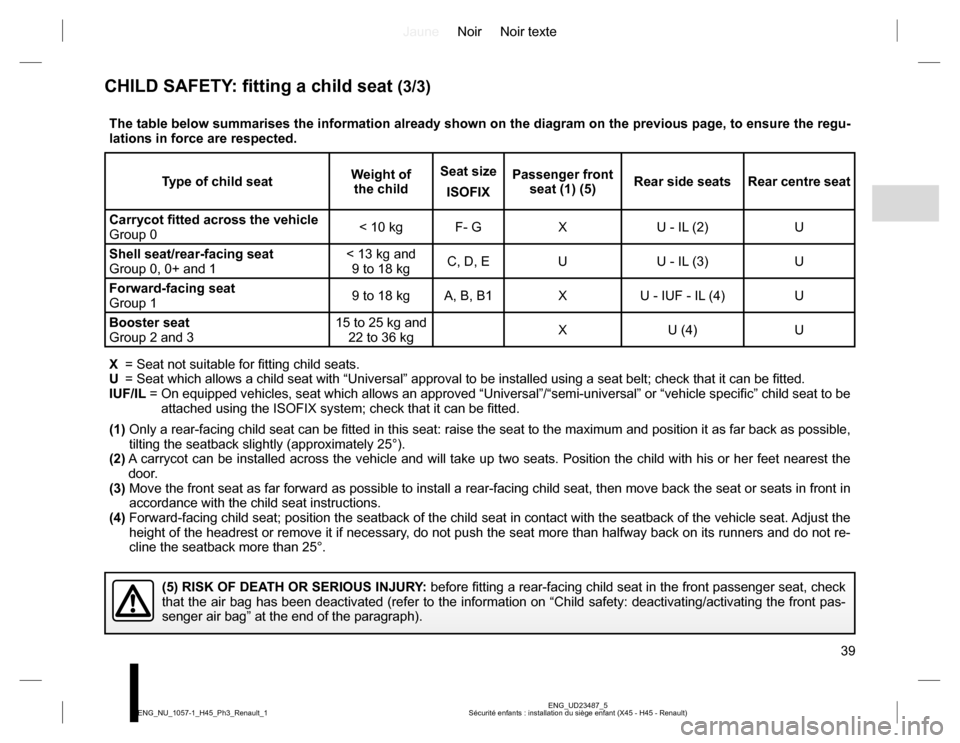
JauneNoir Noir texte
39
ENG_UD23487_5
Sécurité enfants : installation du siège enfant (X45 - H45 - Renault) ENG_NU_1057-1_H45_Ph3_Renault_1
CHILD SAFETY: fitting a child seat (3/3)
(5) RISK OF DEATH OR SERIOUS INJURY: before fitting a rear-facing child seat in the front passenger seat, check
that the air bag has been deactivated (refer to the information on “Child safety: deactivating/activating the front pas-
senger air bag” at the end of the paragraph).
The table below summarises the information already shown on the diagram on the previous page, to ensure the regu-
lations in force are respected.
Type of child seatWeight of
the childSeat size
ISOFIXPassenger front
seat (1) (5)Rear side seats Rear centre seat
Carrycot fitted across the vehicle
Group 0< 10 kg F- G X U - IL (2) U
Shell seat/rear-facing seat
Group 0, 0+ and 1< 13 kg and
9 to 18 kgC, D, E U U - IL (3) U
Forward-facing seat
Group 19 to 18 kg A, B, B1 X U - IUF - IL (4) U
Booster seat
Group 2 and 315 to 25 kg and
22 to 36 kgX U (4) U
X = Seat not suitable for fitting child seats.
U = Seat which allows a child seat with “Universal” approval to be installed using a seat belt; check that it can be fitted.
IUF/IL =
On equipped vehicles, seat which allows an approved “Universal”/“semi-universal” or “vehicle specific” child seat to be
attached using the ISOFIX system; check that it can be fitted.
(1) Only a rear-facing child seat can be fitted in this seat: raise the seat to the maximum and position it as far back as possible,
tilting the seatback slightly (approximately 25°).
(2) A carrycot can be installed across the vehicle and will take up two seats. Position the child with his or her feet nearest the
door.
(3) Move the front seat as far forward as possible to install a rear-facing child seat, then move back the seat or seats in front in
accordance with the child seat instructions.
(4) Forward-facing child seat; position the seatback of the child seat in contact with the seatback of the vehicle seat. Adjust the
height of the headrest or remove it if necessary, do not push the seat more than halfway back on its runners and do not re-
cline the seatback more than 25°.
Page 40 of 232
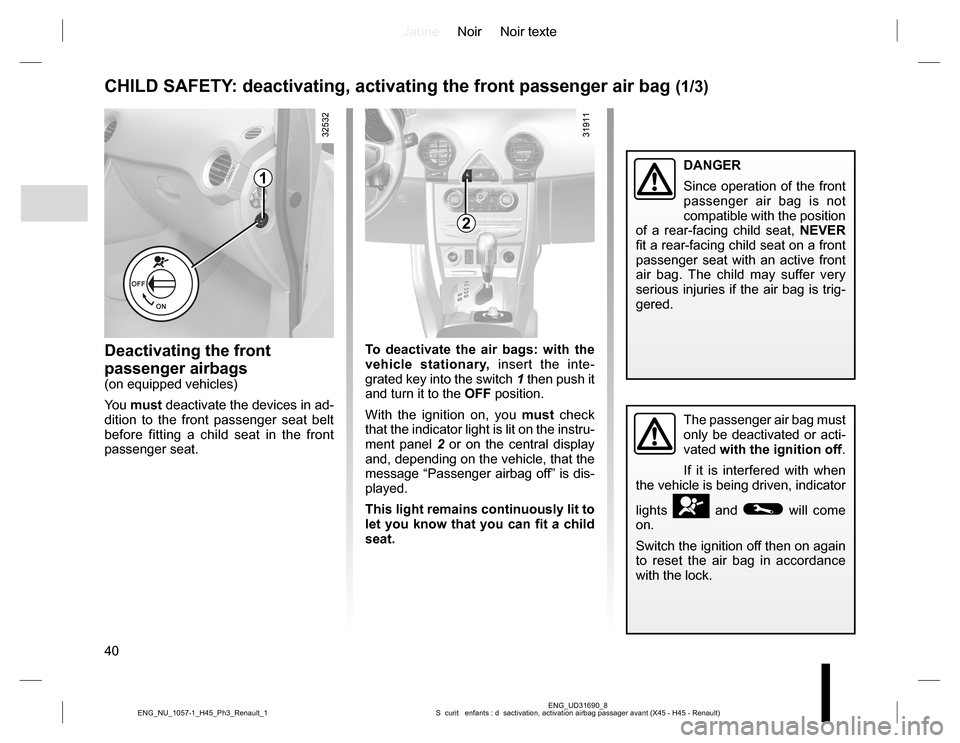
JauneNoir Noir texte
40
ENG_UD31690_8
S curit enfants : d sactivation, activation airbag passager avant (X45 - H45 - Renault) ENG_NU_1057-1_H45_Ph3_Renault_1
CHILD SAFETY: deactivating, activating the front passenger air bag (1/3)
Deactivating the front
passenger airbags
(on equipped vehicles)
You must deactivate the devices in ad-
dition to the front passenger seat belt
before fitting a child seat in the front
passenger seat.To deactivate the air bags: with the
vehicle stationary, insert the inte-
grated key into the switch 1 then push it
and turn it to the OFF position.
With the ignition on, you must check
that the indicator light is lit on the instru-
ment panel 2 or on the central display
and, depending on the vehicle, that the
message “Passenger airbag off” is dis-
played.
This light remains continuously lit to
let you know that you can fit a child
seat.
2
1
The passenger air bag must
only be deactivated or acti-
vated with the ignition off.
If it is interfered with when
the vehicle is being driven, indicator
lights
å and © will come
on.
Switch the ignition off then on again
to reset the air bag in accordance
with the lock.
DANGER
Since operation of the front
passenger air bag is not
compatible with the position
of a rear-facing child seat, NEVER
fit a rear-facing child seat on a front
passenger seat with an active front
air bag. The child may suffer very
serious injuries if the air bag is trig-
gered.
Page 42 of 232
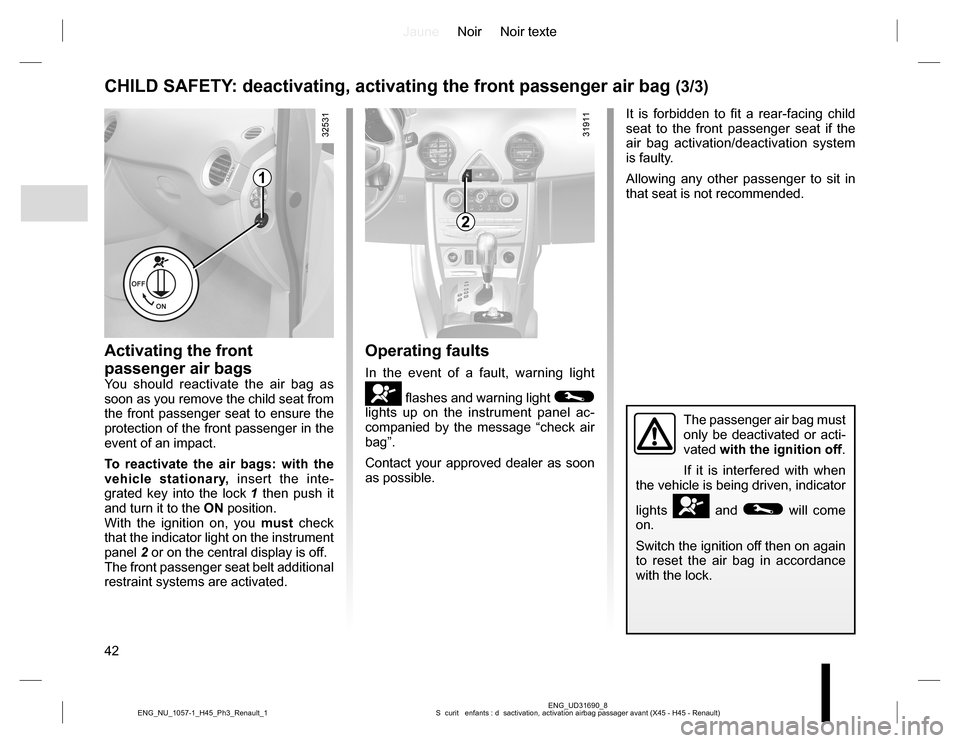
JauneNoir Noir texte
42
ENG_UD31690_8
S curit enfants : d sactivation, activation airbag passager avant (X45 - H45 - Renault) ENG_NU_1057-1_H45_Ph3_Renault_1
CHILD SAFETY: deactivating, activating the front passenger air bag (3/3)
Activating the front
passenger air bags
You should reactivate the air bag as
soon as you remove the child seat from
the front passenger seat to ensure the
protection of the front passenger in the
event of an impact.
To reactivate the air bags: with the
vehicle stationary, insert the inte-
grated key into the lock 1 then push it
and turn it to the ON position.
With the ignition on, you must check
that the indicator light on the instrument
panel 2 or on the central display is off.
The front passenger seat belt additional
restraint systems are activated.
2
1
Operating faults
In the event of a fault, warning light
å flashes and warning light ©
lights up on the instrument panel ac-
companied by the message “check air
bag”.
Contact your approved dealer as soon
as possible.
The passenger air bag must
only be deactivated or acti-
vated with the ignition off.
If it is interfered with when
the vehicle is being driven, indicator
lights
å and © will come
on.
Switch the ignition off then on again
to reset the air bag in accordance
with the lock.
It is forbidden to fit a rear-facing child
seat to the front passenger seat if the
air bag activation/deactivation system
is faulty.
Allowing any other passenger to sit in
that seat is not recommended.
Page 45 of 232
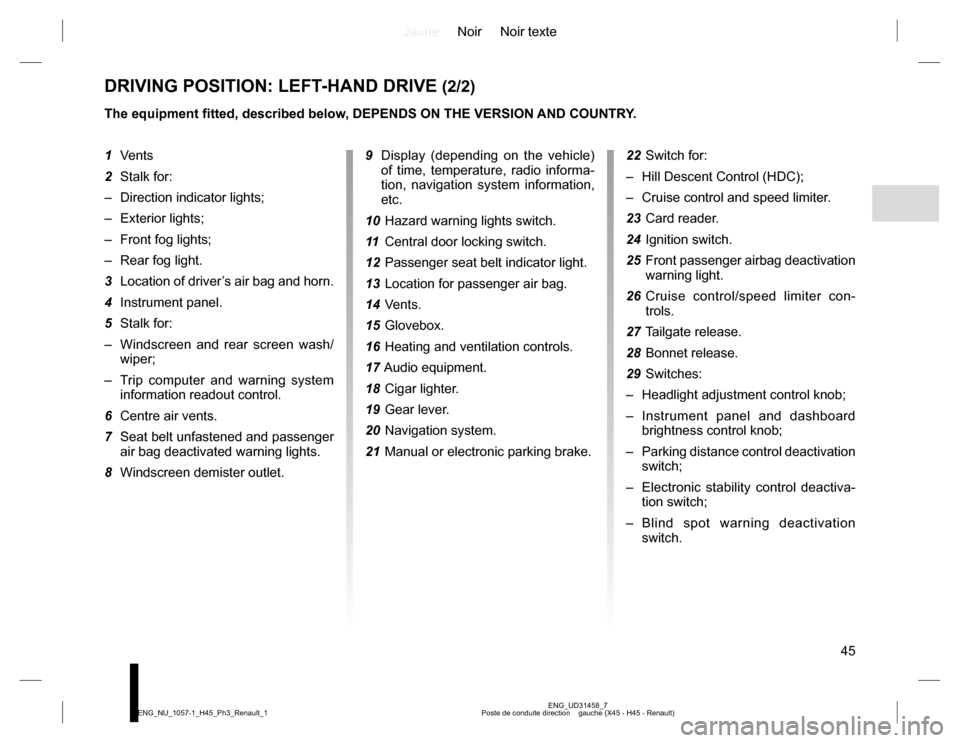
JauneNoir Noir texte
45
ENG_UD31458_7
Poste de conduite direction gauche (X45 - H45 - Renault) ENG_NU_1057-1_H45_Ph3_Renault_1
DRIVING POSITION: LEFT-HAND DRIVE (2/2)
The equipment fitted, described below, DEPENDS ON THE VERSION AND COUNTRY.
9 Display (depending on the vehicle)
of time, temperature, radio informa-
tion, navigation system information,
etc.
10 Hazard warning lights switch.
11 Central door locking switch.
12 Passenger seat belt indicator light.
13 Location for passenger air bag.
14 Vents.
15 Glovebox.
16 Heating and ventilation controls.
17 Audio equipment.
18 Cigar lighter.
19 Gear lever.
20 Navigation system.
21 Manual or electronic parking brake.22 Switch for:
– Hill Descent Control (HDC);
– Cruise control and speed limiter.
23 Card reader.
24 Ignition switch.
25 Front passenger airbag deactivation
warning light.
26 Cruise control/speed limiter con-
trols.
27 Tailgate release.
28 Bonnet release.
29 Switches:
– Headlight adjustment control knob;
– Instrument panel and dashboard
brightness control knob;
– Parking distance control deactivation
switch;
– Electronic stability control deactiva-
tion switch;
– Blind spot warning deactivation
switch. 1 Vents
2 Stalk for:
– Direction indicator lights;
– Exterior lights;
– Front fog lights;
– Rear fog light.
3 Location of driver’s air bag and horn.
4 Instrument panel.
5 Stalk for:
– Windscreen and rear screen wash/
wiper;
– Trip computer and warning system
information readout control.
6 Centre air vents.
7 Seat belt unfastened and passenger
air bag deactivated warning lights.
8 Windscreen demister outlet.